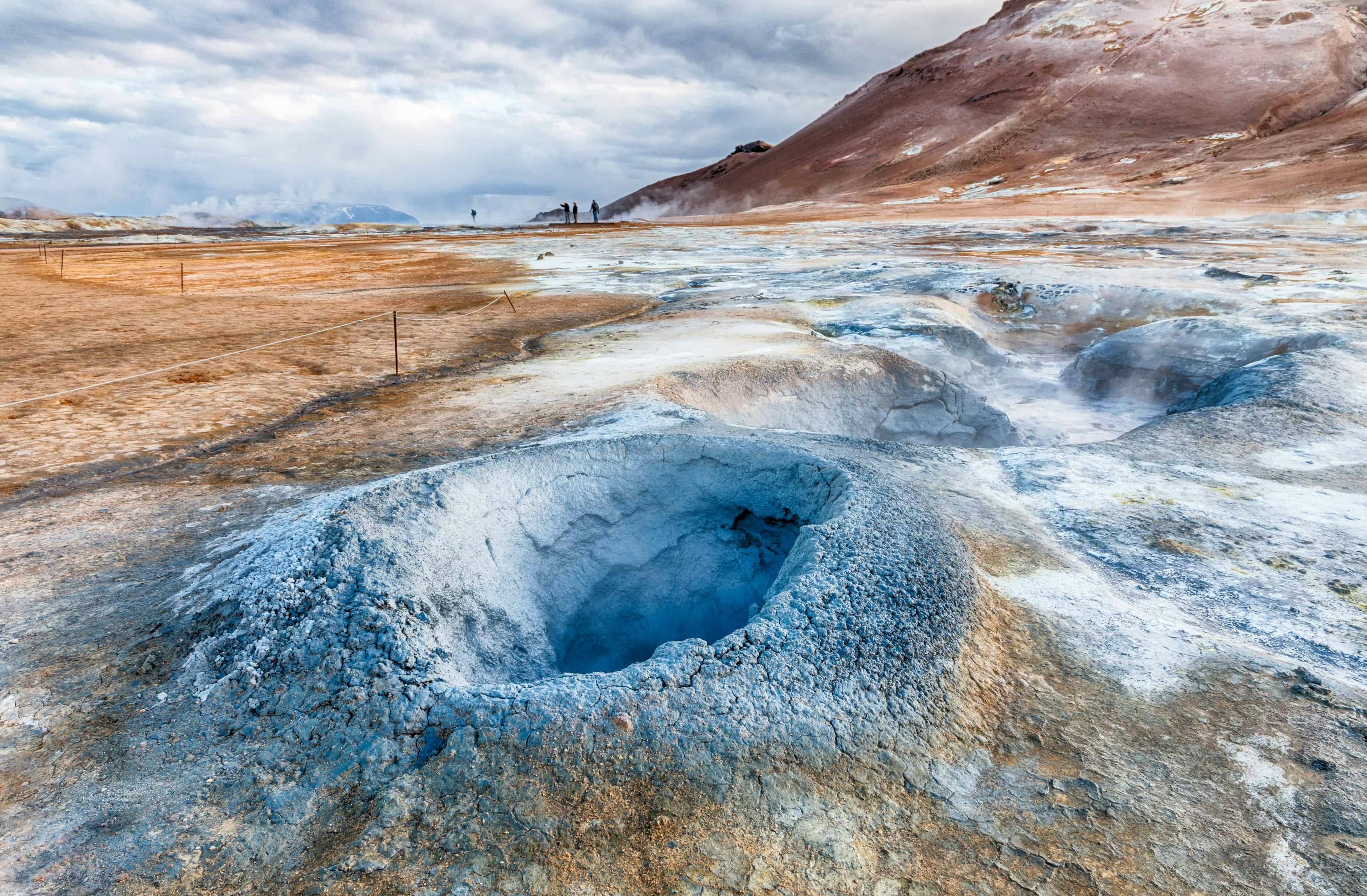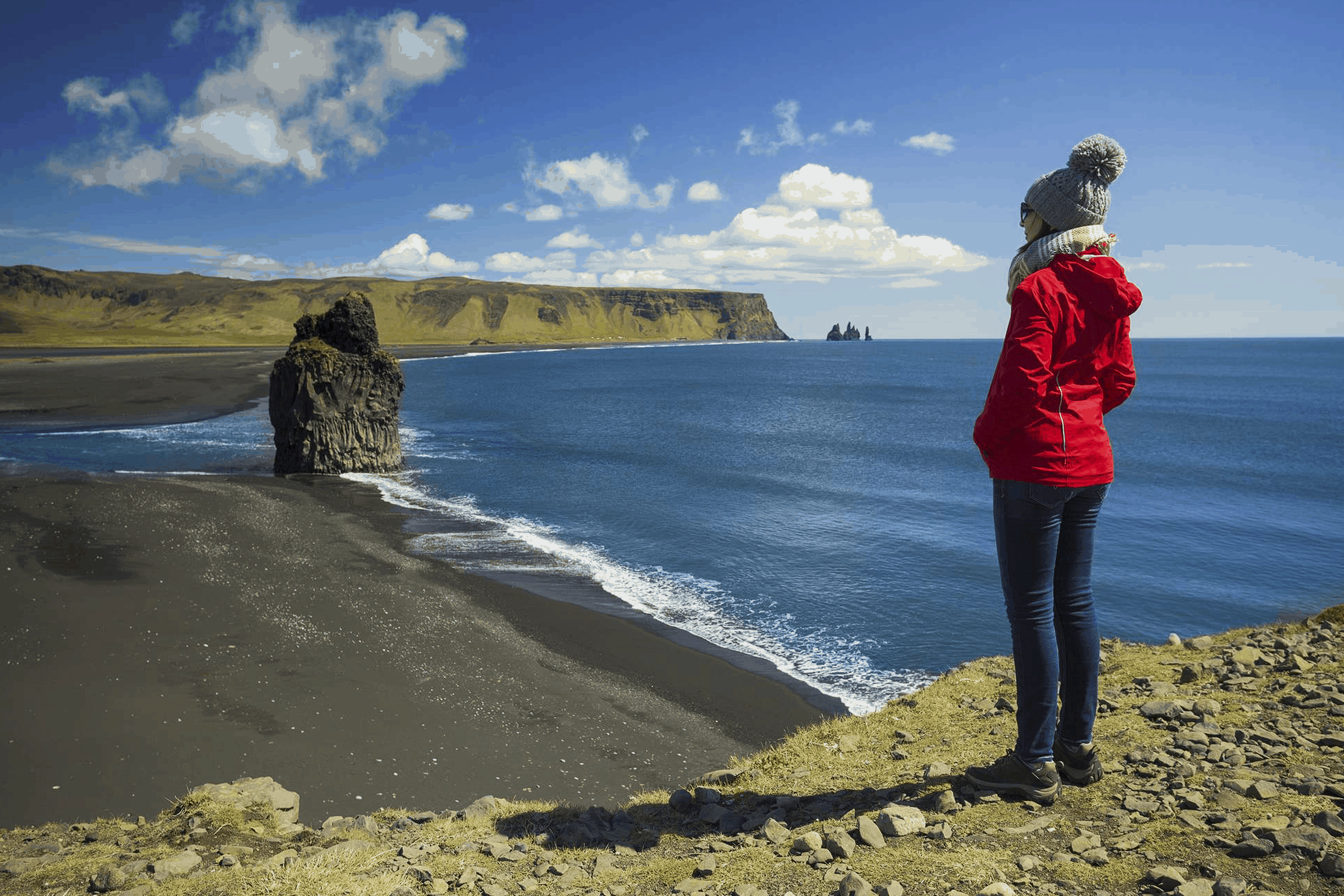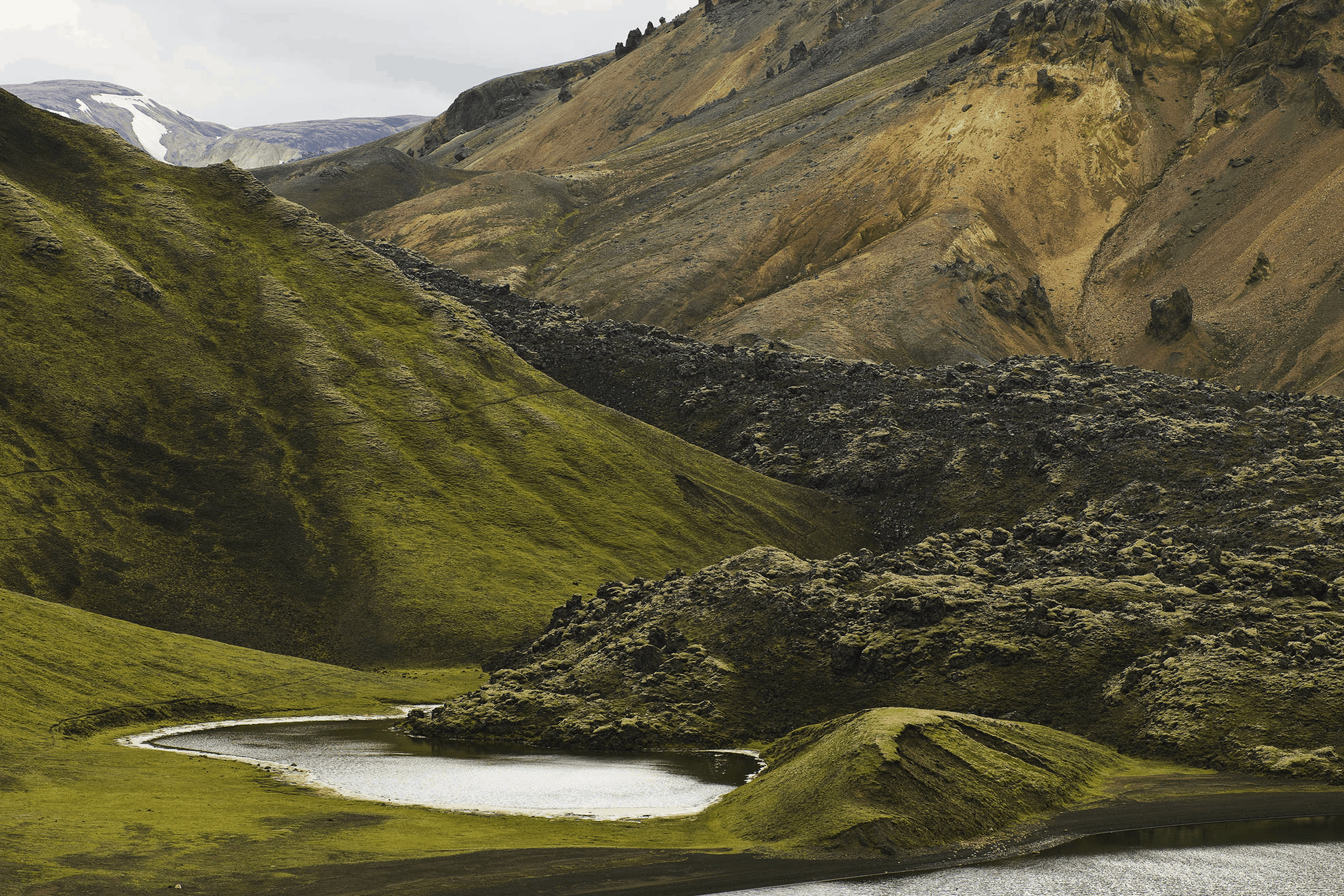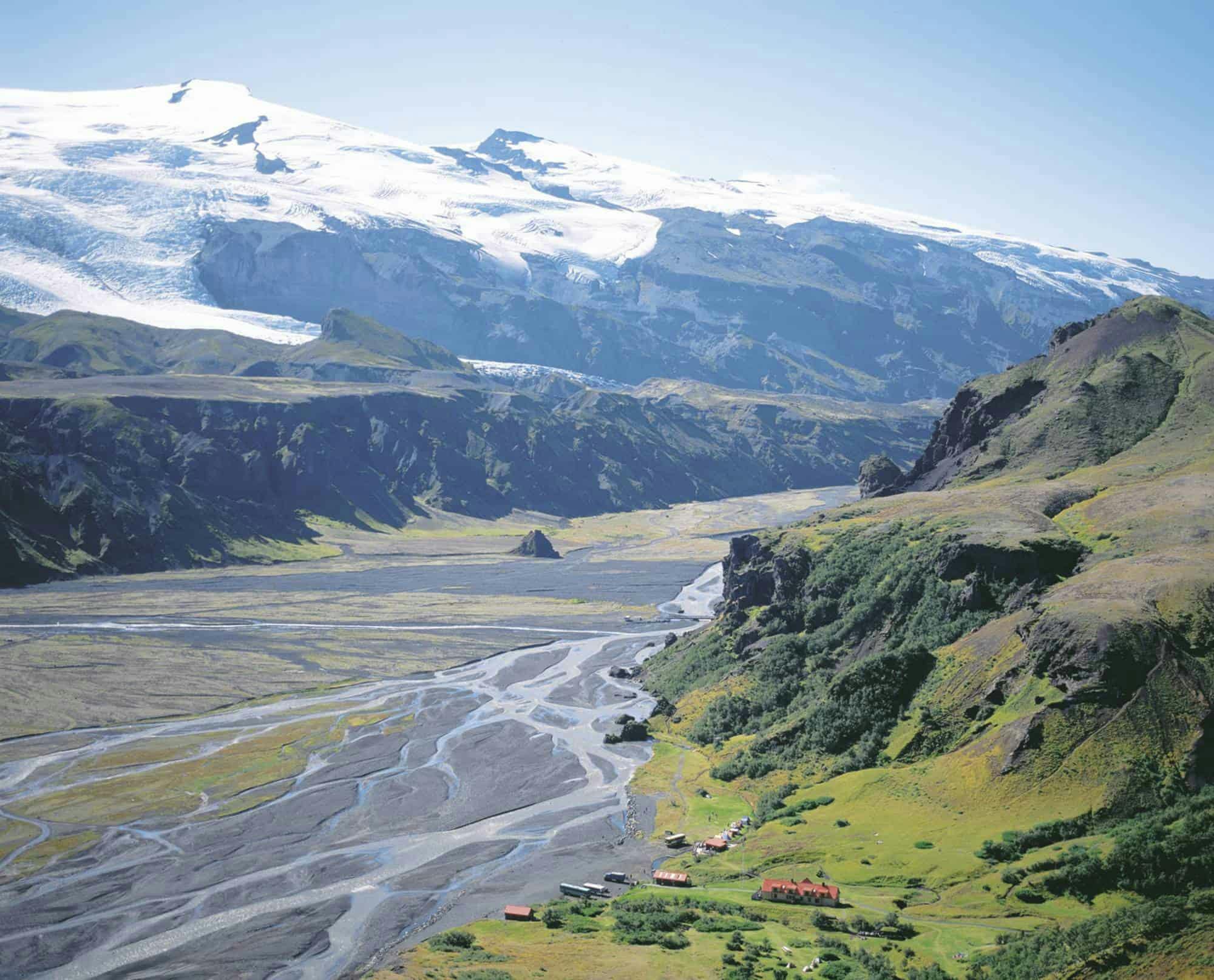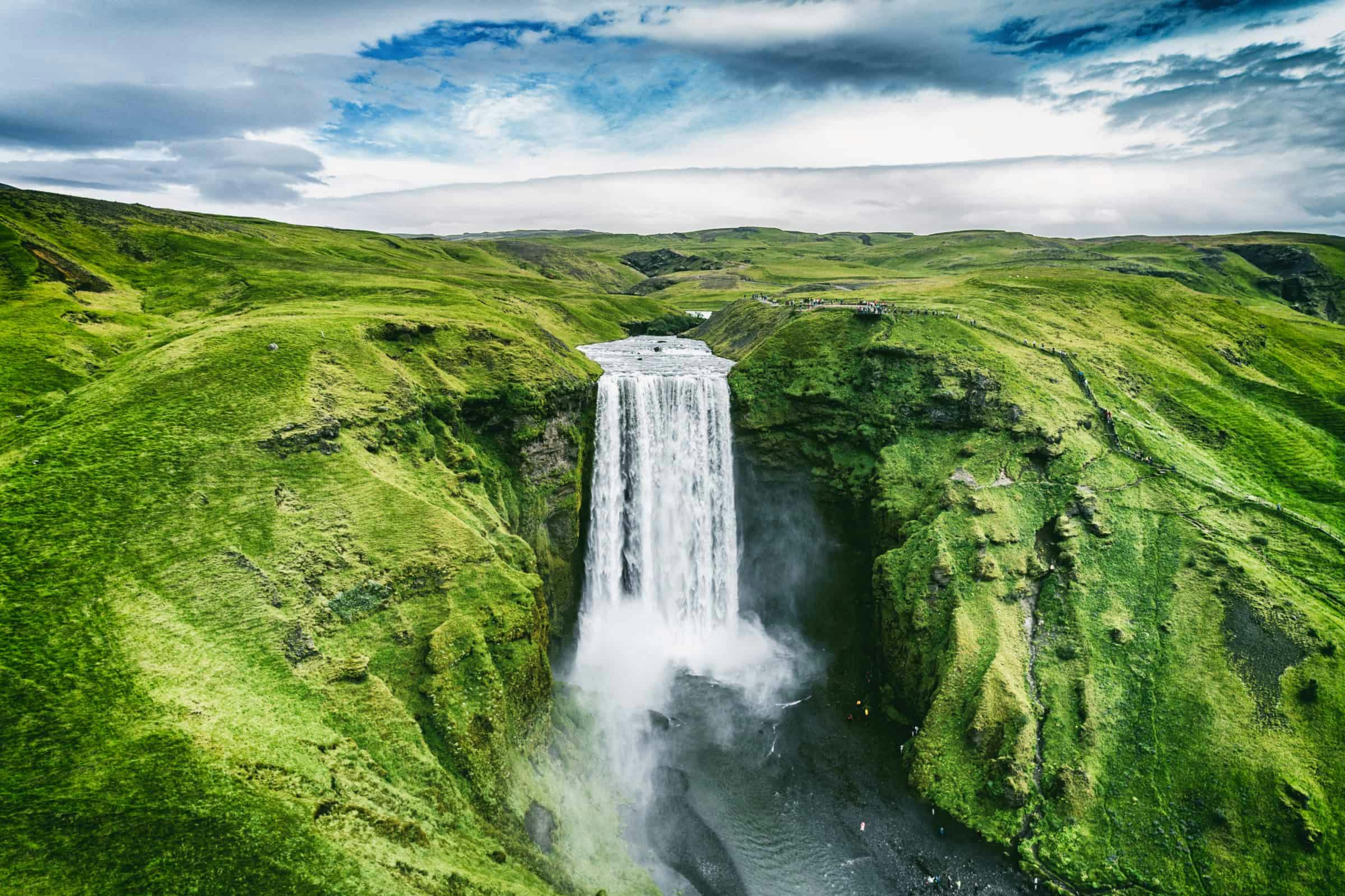Nature
Iceland is paradise for nature and outdoor lovers with an astonishing variety in stunning landscapes. Where else in one place can you find 800 hot springs, 10,000 waterfalls, 35 active volcanoes, the Northern Lights and Europe’s largest glacier?
Iceland’s scenic coastline is dotted with more than a hundred gorgeous fjords, many with green, fertile valleys. But what is a fjord exactly? Geologically, a fjord is a long, narrow inlet with steep sides or cliffs, created in a valley carved by glacial activity. In Iceland during the Ice Age, massive glaciers carved out the plunging fjords which cut into the coastline on the north, east and west and created razor sharp mountain ridges
Some samples:
Latrabjarg Cliffs
Iceland’s exotic Westfjords are home to the colossal Latrabjarg cliffs, the largest bird cliff in the world. The variety and sheer number of birds that can be seen here at one time are astounding with a constant stream of thousands of birds. This majestic cliff’s claim to fame is that it is the westernmost point in Europe and hosts Iceland’s greatest concentration of seabirds.
Thousands of Iceland’s iconic puffins frolic about and are not shy about having their picture taken. Other species that can be found here include gannets, guillemots, razorbills, white-tailed eagles, red-throated loons, arctic terns, redshanks, snipes, auks, murres, kittiwakes, fulmars, snow buntings, and ringed plovers.
Myvatn & Husavik
Lake Myvatn is an outstandingly beautiful region in northern Iceland known for its spectacular volcanic activity and as a major breeding ground for birds with more species of breeding ducks than anywhere else in Europe.
Common to Lake Myvatn are scoter ducks, Eurasian widgeons, tufted ducks, barrow’s goldeneye, scaups, harlequin ducks, whimbrels phalaropes, golden plovers, and you may also see gold crests and birds of prey including short-eared owls and gyrfalcons. Don’t miss a chance to visit the Sigurgeir Bird Museum on the nearby Neslandatangi peninsula.
In Húsavík about an hour’s drive away on the northern shoreline there are a good number of breeding purple sandpipers, Arctic terns, snow buntings, as well as ptarmigans and occasionally a hunting gyrfalcon.
Reykjanes
Located less than an hour from Reykjavik, the Reykjanes peninsula is an area typified by vast lava fields as well as sandy beaches and marshlands which provide the home to several breeding colonies of migrant birds. Probably the best known cliffs for bird watching are the towering Krisuvikurbjarg cliffs in Krysuvik with a wide variety of species including guillemots, razorbills, fulmars, kittiwakes, as well as puffins, herring gulls, and shags.
Breidafjordur Fjord & Flatey Island
Breidafjordur Fjord is a beautiful bay located in western Iceland, surrounded by mountains including the Snaefellsjokull glacier capped volcano. Within the bay are thousands of tiny islands which provide tranquil nesting grounds for around 50 different bird species including puffins, sea eagles, shags, cormorants and sometimes white-tailed eagle can also be seen there.
The only inhabited island in Breidafjordur Fjord is Flatey Island which can be reached by ferry and is home to a wide variety of bird species including black guillemots, red-necked phalaropes, redshanks, meadow pipits, redwings, eider ducks and the rare red phalarope.
The Vestmannaeyjar Islands
The bird watching scene in the Vestmannaeyjar Islands is most famous for Iceland’s lovable and iconic puffin, or ‘lundi’ in Icelandic. If accessed by ferry the bird watching can begin from the sea as thousands of these tiny playful birds jump from the cliffs and dive into the ocean in search for food.
A fun and family event occurs every August on the island of Heimaey during ‘Flight of the Puffling’ when the baby puffins leave their nests for the very first time to test their wings. Visitors and locals often help rescue those who fumble at their attempt at flight!
Fjords in Iceland
The closest fjord to the capital city of Reykjavik is Hvalfjordur, or Whale Fjord, which isn’t named for any marine mammals you’ll spot there but rather for a wonderful folkloric legend about the red hat wearing whale Raudhofdi. This picturesque fjord makes for a wonderful drive (62 km / 39 mi) revealing mountainous landscapes and rural scenery.
The East Fjords are one of the oldest regions of Iceland, shaped by glacial action in the Ice Age where magma chambers that had been 3 kilometers (1.8 mi) underneath the surface where uncovered to reveal beautiful rock formations. This area has a magnificent landscape of long, narrow fjords and steep mountains with jagged peaks. The East Fjords have many natural harbors with flourishing fishing villages that are accessible by boat or car. Some of the more remote fjords are mostly uninhabited and can only be reached by hiking tours throughout the deserted regions of high mountain ridges and verdant valleys.
The Westfjords are sparsely populated, remote and relatively inaccessible with whole areas that are deserted, creating natural reserves of beauty and fertility unknown elsewhere in Iceland. The region offers Iceland’s most dramatic fjords with rough and steep mountain slopes and brilliant blue seas. It is a favorite area for extreme sports such as heli-skiing and has some of the country’s best hiking, particularly at Hornstrandir nature reserve and the dramatic cliffs at Latrabjarg with millions of breeding sea birds.
Glaciers
Glaciers cover more than 10% of Iceland’s surface, and provide a natural classroom for people interested in learning about our numerous glaciers, ice caps and outlet glaciers. Glaciers are enduring objects of fascination and many people visit Iceland just for the ‘hands on’ interaction with these ancient ice forms.
Iceland is home to three of Europe’s largest glaciers, Langjokull and Hofsjokull in the central highlands, and Vatnajokull in the southeast which is larger than all of Europe’s glaciers combined. Measuring an area of 8,300 square kilometers (3,200 sq mi) it covers a number of volcanoes as is often the case with glaciers in Iceland. Other ice caps that conceal fiery secrets beneath are Hofsjokull, Snaefellsjokull on the Snaefellsnes peninsula, the famed Eyjafjallajokull, and Myrdalsjokull in South Iceland which covers the overdue Katla volcano.
Although many of Iceland’s glaciers are accessible for exciting adventure activities and may seem like an icy playground, there are dangers in hidden cracks, deep crevasses and sometimes quicksand at the outlying edges so travelers should only visit on organized tours with experienced operators and guides.
Interesting fact: Glaciers are not affected by the sun, and they have their own weather systems!
Iceland’s largest glacial masses in size order:
| Glacier or Ice Cap | Area (sq km) | Area (sq m) |
| Vatnajokull | 8,300 | 3,200 |
| Langjokull | 953 | 368 |
| Hofsjokull | 925 | 357 |
| Myrdalsjokull | 596 | 230 |
| Drangjokull | 160 | 62 |
| Eyjafjallajokull | 78 | 30 |
| Tungnafellsjokull | 48 | 19 |
| Thorisjokull | 32 | 12 |
| Eiriksjokull | 22 | 8 |
| Thrandarjokull | 22 | 8 |
| Tindfjallajokull | 19 | 7 |
| Torfajokull | 15 | 6 |
| Snaefellsjokull | 11 | 4 |
Volcanoes
Determining the influence of volcanoes to Iceland’s existence would be similar to determining the influence of eggs in an omelet. Iceland formed from an eruption on the ocean floor 20 million years ago, and is still one of the most volcanic hotspots in the world. This is due to the island’s location along the Mid Atlantic Ridge where the N. American and European tectonic plates are being pulled apart, causing continuous volcanic activity.
On average, Iceland experiences an eruption every five years, but fortunately only rarely where anyone lives. It has been estimated that a third of the planet’s total lava flow over the past 500 years comes from Iceland.
There are over 100 volcanoes on the island, 35 of which are active. From strato-volcanoes to the shield variety, almost every type of volcano exists here and southern Iceland has the highest concentration of sub-glacial volcanoes in the world.
Icelanders have learned to constructively coexist with their fiery friends by harnessing volcanic geothermal power to produce clean, renewable energy to heat homes, businesses and of course lovely outdoor swimming pools.
Although it would take some time to describe all of Iceland’s 100+ volcanoes, there are a few worth mentioning including several ways you can safely interact with volcanoes in interesting ways.
Waterfalls
There are around 10,000 plus waterfalls in Iceland, and they are as varied and beautiful as they are many. Iceland‘s climate and location is especially suited to waterfalls with frequent rain and snow, combined with the multitude of glaciers that melt in summer. Some of them have unique characteristics such as waterfalls that run warm with geothermal water, or appear frozen in mid cascade during winter.
There’s a waterfall where you can walk behind the water curtain, while another is the most powerful in Europe. Although all of our waterfalls are beautiful and unique in their own way we’ve mentioned here just a few favorites:
Dettifoss
The most powerful waterfall in Europe, its misty spray can be seen from several kilometers away. It’s located in the northeast and is part of the Jokulsargljufur National Park. The waterfall is a 100 meters and has a drop of 44 meters into the jokulsargljufur canyon. Dettifoss is easily accessible from the road and is part of the famous Diamond Circle route.
Gullfoss
Perhaps the most famous waterfall in Iceland, the Golden Falls are a part of the Golden Circle which also includes Geysir hot spring and Thingvellir National Park. Situated in the upper part of the Hvitá river, Gullfoss cascades down in two tiers, one 11 meters high, and the other 22 meters, into the crevasse below.
Skogafoss
Skogafoss is one of the largest waterfalls in Iceland. Due to its size (25 meter wide with a drop of 60 meters) it produces a massive cloud of spray and on sunny days a rainbow, or even a double rainbow is almost always visible. You can climb the 370 steps to the top for a fantastic view over the southern coastline. It’s propably one of the most photographed waterfalls in the country.
Seljalandsfoss
Seljalandsfoss is kind of Skogafoss‘ twin, because they are most often visited together. The waterfall is tall and narrow with a drop of 60 meters, but what really makes it stand out is the fact that visitors can walk behind it into a small cave for a unique perspective.
Barnafoss
Located in West Iceland Barnafoss (Children’s Falls) is, as the name suggests, not very tall. It’s short and powerful rapids cut through a narrow canyon and has a distinctive pale blue colour. Barnafoss to be named after two young boys who fell in while trying to cross a natural stone bridge over the waterfall while their parents were at church. Their mother put a curse on the bridge that no man could cross it without drowning and shortly after it was destroyed in an earthquake.
Dynjandi
The gem of the remote Westfjord, Dynjandi waterfall, most closely resembles a tiered wedding cake. The spectacular sight is the combination of seven small waterfalls that together are over 100 meters high. Each of the seven waterfalls is individually named and you can even walk behind the third one, Gongufoss.
Hot springs and Geological Wonders
For the geological minded, Iceland is a true gem, one that you need to visit and study. The island, being in geological sense rather young, rests upon a hot spot, so over the last twenty million years volcanic eruptions have created rugged, alien landscape, with diverse volcanic features, ranging from the smallest hot spring and the mighty geysers to huge and powerful volcanoes, resting under glacial caps, their slumber unrestful.
Moss covered lavafields where the artic fox and field mice call their home, enormous explosion craters, bizarre geological formation, ice caves and lava tubes are all monuments to the island’s unique location along the mid-Atlantic ridge, where the North-American and the European tectonic plates meet.
Everywhere you go in Iceland you can find evidence of these powerful and great natural forces, even in capital Reykjavik you can find hot springs and just a few minutes car ride will take you to the mt. Bláfjöll, the volcano region responsible for the 6000 year old lavafield on which a great part of the city stands.
You can also drive a little further east and see the geothermal hot springs in Graendalur and Hveragerdi. If you decide to visit the northern part of Iceland make sure you stop by lake Myvatn and go on a hike through the Dimmuborgir lavafield (especially if your musical taste includes a Norwegian band with the same name). While you’re at lake Myvatn it’s also interesting to visit Krafla geothermal plant.
Natural Spas
Some like it hot! Blessed by an abundance of geothermally heated water and volcanic topography, outdoor bathing in nature spas is a favorite activity enjoyed by both locals and visitors to Iceland. There are wonderful locations with stunning vistas to enjoy these hidden gems throughout the country. Here are a few notable natural bathing spas recognized for their unique features and amazing surroundings.
National Parks
Exploring each of Iceland’s three National Parks provides a wide variety in extraordinary nature and historical interest. Thingvellir National Park showcases a wealth of geological formations in the rift valley between the American and Eurasian tectonic plates and is also a World Heritage Site recognized as the original meeting point of Iceland’s, and the worlds, first parliament.
Western Iceland is the location of Snaefellsjokull National Park which begins at the foot of a glacier-capped volcano and reaches to the seashores and mountaintops in an area steeped in ancient Saga folklore.
Vatnajokull National Park in southeast Iceland is Europe’s largest National Park and features some of Iceland’s most extreme and beautiful nature highlights including Iceland’s tallest peak, Europe’s largest glacier, gorgeous hiking trails and an awe-inspiring glacial river canyon.
Thingvellir National Park
Thingvellir is a favorite stop among travelers along the Golden Circle route. It has been a National Park in Iceland since 1928 and was named a World Heritage site by UNESCO in 2004. When Viking settlers arrived in the 10th century it was the site they chose as the meeting place of Althing, the world’s first parliament. The location may seem a bit out of the way, but the unique geology created a natural amphitheater perfect for public speaking including the high rock wall of Logberg (Law Rock), where the laws of the land would be recited from memory.
Besides its historic interest, Thingvellir holds a special appeal for nature lovers. It is the visible site of the Mid-Atlantic Ridge where the North American and Eurasian tectonic plates meet, and are being pulled apart at a rate of 2 cm (nearly an inch) per year. The geology here is not only interesting to learn about but also spectacular to behold. At Almannagja, on the west side of the plain, you can see the easternmost edge of the North American tectonic plate, which is normally submerged in the Atlantic Ocean. On the east side, at the Heidargja Gorge, you are at the westernmost edge of the Eurasian plate.
There is much to explore in the park including the 20 meter (66 ft) Oxara waterfall, and the Nikulasargja Gorge, better known as Peningagja (Money Gorge) because it is a custom to toss coins (and sometimes credit cards!) into the icy-cold water and make a wish. Thingvellir is also home to Lake Thingvallavatn known best for Silfra Gorge, an extraordinary dive site where you are literally swimming between continents in clear, glacial water.
Snaefellsjokull National Park
Snaefellsjokull National Park located on the Snaefellsnes peninsula covers an area of 440 square kilometers (170 sq mi) and extends west down from the glacier capped volcano all the way to the rugged coastline.
Declared a National Park in 2001, the area has an astonishing variety in natural landscapes including moss covered lava fields, pebbled beaches and imposing rugged cliffs. Undoubtedly the crowning jewel is Snaefellsjokull glacier itself which covers a dormant volcano that last erupted in 250 AD. The icy cone-shaped peak can be seen from Reykjavik on a clear day and is considered to be one of the earth’s most powerful centers of spiritual energy.
The area is steeped in ancient, literary and New Age folklore and is the hometown of Gudridur Thorbjarnadottir, an Icelandic woman who traveled extensively around the world in the Middle Ages.
Although there are no campgrounds in the park, during the summer guided walks are scheduled several times a week. When hiking in this area you can expect to discover little beaches, rugged seascapes, rare plants, birdlife and seals.
The seaside shore of Snaefellsnes peninsula is also a good location for spotting orca and minke whales that inhabit the surrounding ocean. The park’s Visitor Center is in the small town of Hellnar and is open daily during the summer.
Vatnajokull National Park
Vatnajokull National Park encompasses an enormous area in southeast Iceland and was officially formed in 2008 by joining together Jokulsargljufur and Skaftafell National Parks. It is the largest National Park in Europe covering an area of 12,000 square kilometers (4,600 sq mi) and could be explored for weeks at a time.
The whole area is dominated by Vatnajokull glacier, which is larger than all of Europe’s glaciers put together. There are lovely views from Route 1 of Vatnajokull and the many outlying glacial tongues that stretch down from the ice cap towards the ocean, indulging you with awe-inspiring scenery.
Here you have an up-close opportunity to experience the interaction between glacial forces and volcanic activities. There are a great variety of hiking trails within the park as well as the possibility for ice climbing, ATV riding and snowmobiling.
The Skaftafell region of Vatnajokull National Park is a lush oasis where you can hike for days on gorgeous trails through forests, waterfalls, black sands, mountains, glaciers with Iceland’s highest peak, Hvannadalshnjukur, reaching 2,118 meters (6,950 feet), providing a stunning backdrop.
A short walk into the park offers a breath taking view of Svartifoss, (Black Falls) which is bordered on both sides by tall black basalt columns, resembling the pipes of a giant organ.
Literally translated, Jokulsargljufur means glacial-river-canyon and it is aptly named for the country’s longest river canyon at 25 kilometers (16 mi). Jokulsargljufur makes up the northeastern region of Vatnajokull National Park and there are several must-see natural sites in this area including Dettifoss, Europe’s most powerful waterfall and Ásbyrgi, the remarkable horseshoe shaped canyon which Viking settlers believed to be a hoof-print formed by Sleipnir, Odin’s flying horse from Norse mythology and folklore tales.
Mountains, caves and lava tubes
Lava tubes are a type of lava cave that form when slow flowing lava cools and solidifies on the tops and sides during an eruption. Once the eruption ceases the lava drains from these ‘channels’ and a new lava tube cave is left behind.
Lava tubes contain many amazing features to discover including mineral stalactites and stalagmites, fascinating lava pillars, and ghostly ice sculptures. Some lava tubes become covered in perennial ice over time and become known as ice caves. There are dozens of caves worth seeking out with a professional guide.
